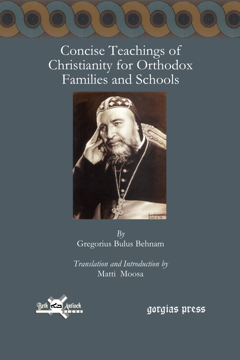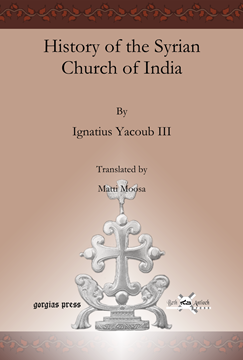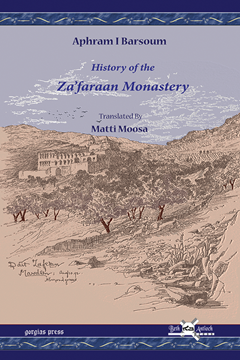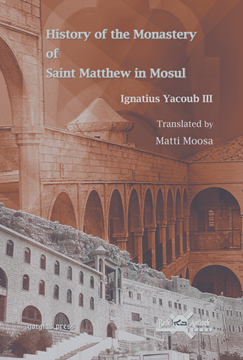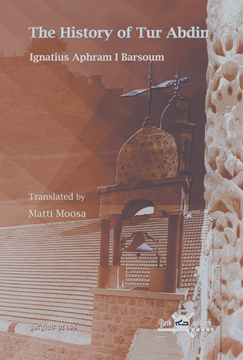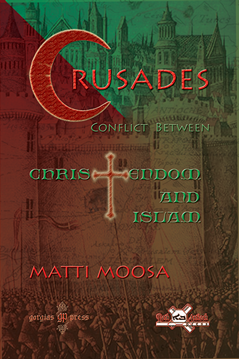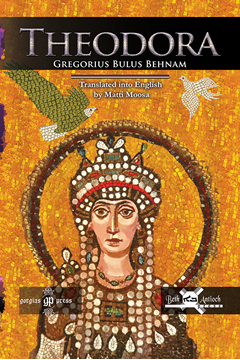Publications of the Archdiocese of the Syriac Orthodox Church
This series publishes works of interest to the members and friends of the Archdiocese of the Syriac Orthodox Church in the Eastern United States.
Concise Teachings of Christianity for Orthodox Families and Schools
By Gregorios Bulus Behnam; Translation and Introduction by Matti Moosa
ISBN: 978-1-4632-0215-6
Matti Moosa provides an introduction and a translation of Rev. Bulus Behnam’s 1946 work on the basic principles of the Christian faith based on the Holy Scriptures, showing that the Syrian Church considers the Holy Bible its sole authority for salvation.
$67.00 (USD)
History of the Syrian Church of India
By Ignatius Yacoub III; Translated by Matti Moosa
ISBN: 978-1-59333-982-1
This book covers the history of the Syrian church of India from its founding by the apostle Thomas in 52 A.D., until the first half of the 20th century. During which, the author explains the various obstacles the Indian Church faced in therms of theology and colonialism. The several delegations of the Apostolic See of Antioch to India from the 17th to the 20th centuries form an indispensable account of the vicissitudes of a struggling native Indian Church trying to preserve its Antiochene identity.
$166.00 (USD) $99.60 (USD)
Commentary on the Liturgy of the Syrian Orthodox Church of Antioch
By Ishaq Saka; Translated by Matti Moosa
ISBN: 978-1-60724-002-0
The exposition of the Liturgy of St. James, which is basically the Celebration of the Holy Eucahrist, is most significant for the understanding of the mystery of God in offering His only Son a vicarious sacrifice for the redemption of man. To make it understandable, Rev. Saka explains not only the meaning of terms connected with the liturgy but of all the components of the vessels, the vesting, the censoring, the candles and the propitiatory prayers associated with them. This exposition should benefit both church and liturgical scholars and lay people interested in the profound spiritual meaning of their faith.
$112.00 (USD) $67.20 (USD)
History of the Za’faraan Monastery
By Ignatius Aphram I Barsoum; Translated by Matti Moosa
ISBN: 978-1-59333-639-4
The History of the Za’faran Monastery is for the first time offered in English translation to the readers. It was written in 1917 by Patriarch Ignatius Aphram Barsoum (d. 1957) when he was still a monk at the monastery. The book details the history of the monastery from its inception until modern times. It deals with with everything, from construction to its significance as a center of Syriac learning and learned men. Without this small book, the first of its kind, a great and significant page of the history of the Syrian Church of Antioch would have been lamentably lost.
$111.00 (USD) $66.60 (USD)
History of the Monastery of Saint Matthew in Mosul
Translated by Matti Moosa
ISBN: 978-1-59333-788-9
Located north of Mosul, St. Matthew’s Monastery—commonly known as Dayr Sheikh Matti—is perhaps the most ancient religious institution in Iraq. Although the Syriac life story of St. Matthew was published together with that of St. Behnam by Paul Bedjan in 1891, and translated into Arabic by Elias Behnam, this present account is more extensive and informative. It includes in-depth physical and spiritual descriptions of the monastery as an outstanding institution which played a significant role in the history of the Syrian Orthodox Church of the East. Mar Ignatius Jacob III offers insight into the monastery’s learned superiors, metropolitans and magnificent library.
$145.00 (USD) $87.00 (USD)
The History of Tur Abdin
English Translation by Matti Moosa
ISBN: 978-1-59333-715-5
Until now this first insider-history of Tur Abdin has been unavailable to non-Semitic readers. Written by Patriarch Ignatius Aphram Barsoum in Syriac, this history of the mountainous region in southeastern Asia Minor called Tur Abdin has not found wide readership because of language barriers. This new edition produced by Gorgias Press is a trilingual edition: the original Syriac, Arabic, and English translations.
$127.00 (USD) $76.20 (USD)
Conflict Between Christendom and Islam
By Matti Moosa
ISBN: 978-1-59333-366-9
This book sheds light on the first three Crusades (1097-1191) by introducing material from several medieval Syriac and Arabic sources and reconciling their accounts with those provided by Western sources. It presents the Crusades as an extension of the conflict between Christianity and Islam, which began with the Arabs’ first incursions into Christian territory in the seventh century and continued with their conquest of the Iberian peninsula.
$367.00 (USD) $220.20 (USD)
Theodora
With Translation and Introduction by Matti Moosa
ISBN: 1-59333-314-5
Western sources have long referred to Theodora as an infamous and salacious courtesan who became Justinian’s empress. Syriac sources portray her as a woman of sublime character and decorum, the daughter of a Syriac priest. This historical play outlines her character according to the Syriac tradition. In writing the play, Bishop Gregorius Boulos Behnam portrayed Theodora as a virtuous lady who won the heart of Justinian, who made her his Augusta and co-regent of his empire. Behnam reveals her extraordinary devotion to her faith and piety as she strives to protect the Fathers of the Syriac Church who stood against the declarations of the Council of Chalcedon and were persecuted for it. Now available for the first time in English, this edition translated by Matti Moosa stands counter to the view of Theodora as portrayed by Procopius in his version of the story, as it is popularly known in Western Christendom.
$58.00 (USD) $34.80 (USD)

